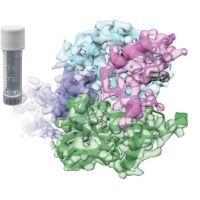Specification
| Organism | Anemonia sulcata (Mediterranean snakelocks sea anemone) |
| Expression Host | Yeast |
| Tag Info | N-terminal 6xHis-tagged |
| Purity | Greater than 85% by SDS-PAGE |
| Uniprot ID | P01528 |
| Gene Names | N/A |
| Alternative Names | ATX-II |
| Expression Region | Full Length(1-47aa ) |
| Molecular Weight | 6.9 kDa |
| Protein Sequence | GVPCLCDSDGPSVRGNTLSGIIWLAGCPSGWHNCKKHGPTIGWCCKQ |
| Form | Liquid or Lyophilization |
| Buffer | The default storage buffer is Tris/PBS-based buffer, 5%-50% glycerol if the delivery form is liquid. The lyophilization buffer is Tris/PBS-based buffer, 6% Trehalose, pH 8.0 if the delivery form is lyophilized powder. Please contact us if you have any special requirment. |
| Reconstitution | Please reconstitute protein in deionized sterile water and we recommend that briefly centrifuge thevial prior to opening the vial .We recommend aliquot for long-term storage at -20℃/-80℃. |
Background
| Relevance | Binds specifically to voltage-gated sodium channels (Nav) (site 3), thereby delaying their inactivation. Has a strong effect on crustaceans and insects (DmNav1) and a weaker effect on mammals. This toxin is highly potent at mammalian Nav1.1/SCN1A (EC(50)=6.01 nM) and Nav1.2/SCN2A (EC(50)=7.88 nM) (PubMed:15169781). It has also great activity on Nav1.5/SCN5A (EC(50)=49.05 nM), Nav1.4/SCN4A (EC(50)=109.49 nM) and Nav1.6/SCN8A (EC(50)=about 180 nM) and is less potent on Nav1.3/SCN3A (EC(50)=759.22 nM) (when measured as the increase in the slow component) (PubMed:15169781). |
| Involvement in Disease | |
| Subcellular Location | Secreted, Nematocyst |
| Protein Families | Sea anemone sodium channel inhibitory toxin family, Type I subfamily |
| Tissue Specificity | N/A |
QC Data
| Note | Please contact us for QC Data |
| Product Image (Reference Only) |  |

